Did you peer over the top of your aquarium only to discover that it looks worse than the Deepwater Horizon oil spill in the Gulf of Mexico?
That thick layer of gunk just doesn’t look right. And, it might actually be dangerous to your fish!
Today, I am going to teach you where this mysterious oily film comes from and how you can get rid of it!
Contents
Identifying your oil slick
Depending on the cause, one oily film can look very different from the next.
In some cases, it’s little more than a clear layer of oil that sparkles a rainbow color under your lights. You know, like when you see gasoline on a wet surface.
If this is the case, your oil slick is likely just that. Oil.
In other cases, the film on your aquarium might look gray or white, be difficult to look through and may even clump together in flakes if you stir it…
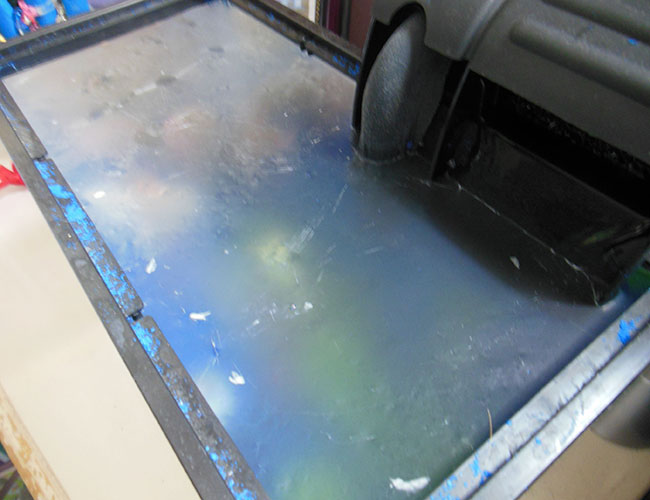
This thin white sludge is a protein film and particularly common in betta tanks. But don’t worry, you can get rid of this protein buildup the same way you get rid of any other greasy film on the surface of your aquarium.
You might hear an oil film referred to as a biofilm. But the truth is, it doesn’t matter what your oil slick looks like, this guide is going to show you how to get rid of it!
What causes oil to appear in your aquarium?
It doesn’t take much oil to create an impressive oil slick. In fact, a drop or two is often all it takes.
But where does this oil or protein come from? Let’s take a closer look at six common causes for the oily film on top of your fish tank.
In some instances, you can solve your oil problem just by fixing the cause…
1. Oil from your hands
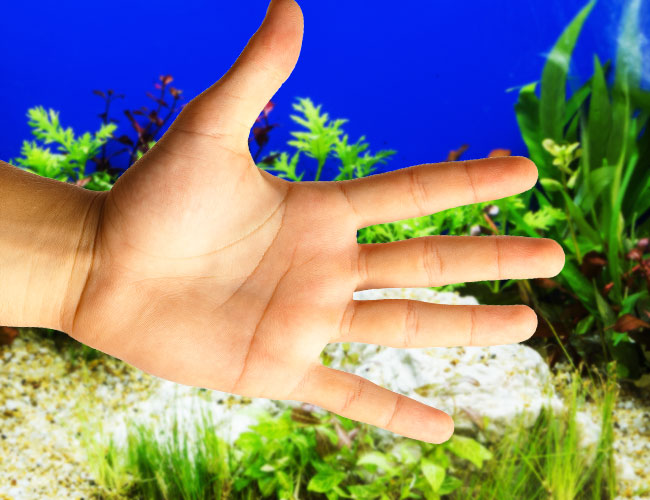
Let’s face it, there are going to be lots of times that you need to get your hands wet. Whether it’s catching a sick fish with a net or adjusting your plants – you need to dunk your hands under water.
This is actually the most common cause of oil slicks.
You see, the pores in your skin naturally secrete oil. It’s such a small amount that you don’t even notice it. And, that doesn’t include any hand lotion or other moisturizers you have slapped on top… Oil City!
When your hand comes into contact with the water, this oil washes off and forms an oil slick on top of your aquarium.
The solution to this one is simple – if you plan on putting your hands in your aquarium, wash them thoroughly first. And, wash off every bit of soap too. You don’t want that in your aquarium either!
Alternatively, buy a pair of aquarium safe gloves and wear those when you work in your tank
2. Fish food
It may surprise you to learn that many different types of fish food contain some form of fat.
When you feed your fish, the food dissolves, and any fats and proteins inside float to the surface.
This is a particular problem if you overfeed your fish. Any food left over from feeding time will continue to dissolve and release the fats trapped inside – as if you needed another reason to not overfeed your fish!
Unfortunately, depending on your fish’s diet, you may not be able to stop using oily, high-protein fish foods. But don’t worry, I’ll show you how to prevent oil slicks later in this guide.
3. Fish poop
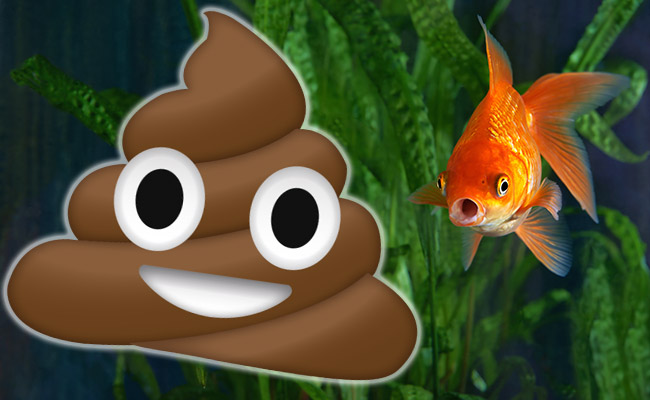
It’s unavoidable… Your fish is going to eventually drop a deuce in your aquarium. And, an oily one at that.
As you might have guessed…
Oily food, oily poop!
But it’s not just that…
A fish’s natural digestive system produces oils and proteins as it breaks down food. And when your fish unleashes its bowels… The oils inside the poop rise to the surface.
And when that happens, an oil slick forms.
4. Filters and pumps
Your new filter could actually be responsible for the giant oil slick.
You see, filters and pumps often have small amounts of oil smeared over their moving parts to lubricate them. Not to mention other oils that were left over from the manufacturing process.
You can minimize the amount of oil your filter releases into your aquarium by giving the filter a wash before use.
5. Dead fish
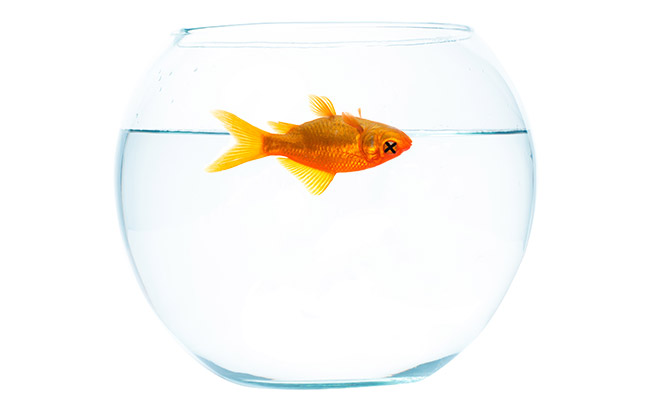
It’s a sad thought, isn’t it? That one day your fish will make the trip to fish heaven.
If you don’t immediately remove the body, it will release fats and oils into the water as it breaks down, as well as a really bad smell.
So if you see an oil slick, it’s time for some fishy roll call, to make sure everyone is accounted for.
6. Poor fish tank location
Made it this far and are confident that nothing else on this list is the cause of the oil slick?
That oil film on the surface of the water may actually be your fault.
It’s easy to forget that those fine mists from aerosols and perfumes have to settle somewhere. And if they settle on your aquarium, they can cause a film to form on the surface of the water.
Similarly, if your fish tank is located too close to your kitchen, airborne grease from cooking can settle on the surface of your fish tank, causing an oil slick to appear.
Ideally, you want to move your aquarium as far away from these sources of contamination as possible.
By choosing the right place to put your aquarium before setting it up avoids problems like this.
Are these oily films dangerous?
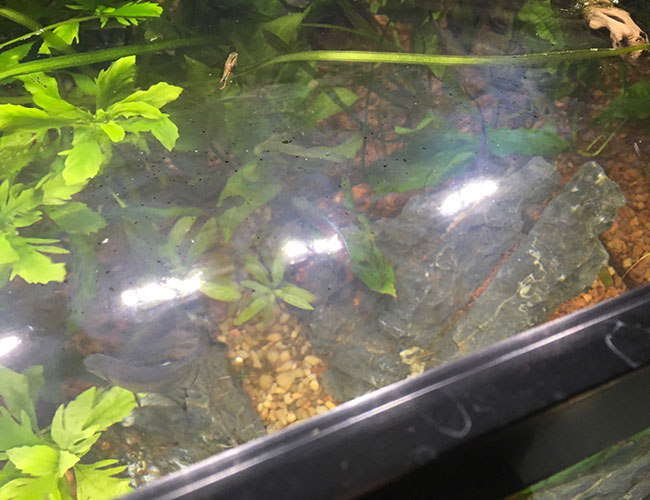
There’s no denying that a greasy rainbow film covering the surface of your aquarium is ugly. But is it dangerous?
Well, such a small amount of oil isn’t going to harm your fish.
Not directly…
However, if it builds up, a film of oil covering the surface of your tank could cause your fish to suffocate.
You see, oxygen enters the water through the surface of your aquarium. And as you know, oxygen is pretty important – your fish need it to breathe.
A thick, oily film can act as a barrier, preventing oxygen from entering your aquarium.
Even a tiny oil slick reduces the amount of oxygen that enters the water. And in an overstocked tank, this could be a disaster… Especially considering that the film isn’t just keeping oxygen out but trapping carbon dioxide in!
Given the risk to your fish, there isn’t a logical argument not to remove the oil slicks from your aquarium…
How do you get rid of greasy surface films?
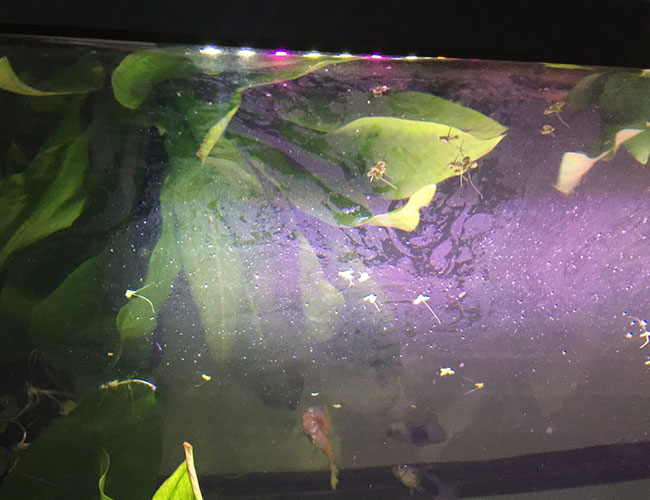
Given all the causes, you may be wondering why every aquarium doesn’t have oil floating on top of them. After all, the causes are pretty common, right?
Well, constant water movement, particularly surface agitation causes the water to churn and swirl. And as it does, it mixes and disperses these small amounts of oils, which are eventually removed through water changes and by rinsing the filter.
This is why aquariums with no water movement are most at risk for oil slicks.
However, if you are reading this, then chances are that the amount of oil on the surface of your aquarium isn’t a small amount.
So, let’s take a closer look at how to remove this oily film as well as taking steps to ensure that it never returns.
1. Immediate removal
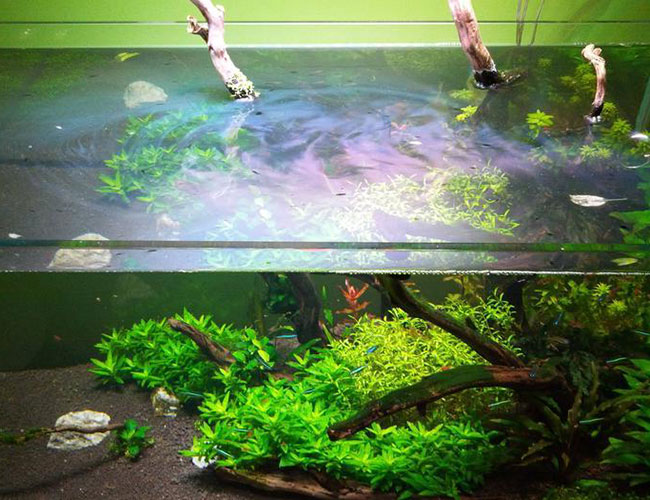
Okay, so there is a giant shimmering film on top of the water, and you want it gone. Now.
You can do just that. And, you just need one piece of equipment. Better yet, chances are that you already have it nearby…
Paper towels!
This absorbent superhero removes any oil that it touches.
The first thing you want to do is to turn off any filters, pumps and power heads – you know, all the stuff that causes water movement in your aquarium.
Once the oil has settled, lay a paper towel over the surface for a few moments before removing it. You should notice that the oily film clings to the surface of the paper towel.
If you have a large tank, or a particularly large oil spill, you may need to repeat this process multiple times until there is no oil remaining.
Alternatively, if you have a steady hand, you can carefully drain the surface scum into a container – measuring cups work great, just make sure it’s clean and free of soap!
Now, let’s take a look at how you can prevent this oily film from coming back for good.
2. Water movement
As I said earlier, water movement is the key to avoiding a layer of oil.
Pointing your filter nozzle at the surface, adding a powerhead, using a spray bar or even the bubbles from an airstone can help mix oils, preventing them from lumping together in a greasy slick.
FishLab Tip: If you have an oil slick in a small area of your tank, it could indicate a dead spot in your aquarium – a location where the water doesn’t circulate. Adjust the position of your filter outflow and power heads to ensure that the water moves around your entire tank, preventing oily patches.
3. Use a surface skimmer
If you are constantly fighting oil slicks, then the Fluval Surface Skimmer is going to be your best friend!
Simply attach a surface skimmer to the inflow of your aquarium filter, and your floating oil film will disappear in minutes, like magic!
How it works is rather simple. The skimmer contains two holes, one at the top and another at the bottom. But it’s the top hole that we are most interested in.
You see, this hole sits in line with the surface of your aquarium. As your filter draws in water, any floating oil, algae and other gunk is sucked down this opening where it is filtered out of the water.

You can find electric surface skimmers. However, I prefer the ones that attach to the filter inflow. The electric ones don’t work any better, are expensive and take up another precious socket on your power strip.
Note: Don’t confuse a surface skimmer with a protein skimmer. A surface skimmer removes floating scum from the top of your aquarium. A protein skimmer uses bubbles to remove unwanted gunk from under water and is typically only used in saltwater aquariums.
Conclusion
While it may look ugly, that oil film in your aquarium shouldn’t give you too much of a headache.
Simply use my tips in this guide and go to town on it!
How do you remove oil slicks from your aquarium? Let me know in the comments below!

Ian Sterling, founder of Fishlab.com, began his aquarium journey over 30 years ago, driven by a deep fascination for fish and their diverse personalities. His website, Fishlab.com, is dedicated to making fishkeeping accessible and enjoyable, offering beginner-friendly guidance, expert insights, and a community for aquarists to connect and share experiences.


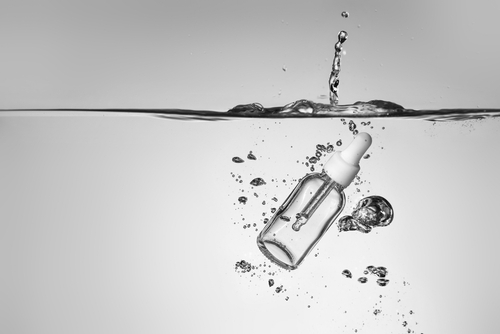

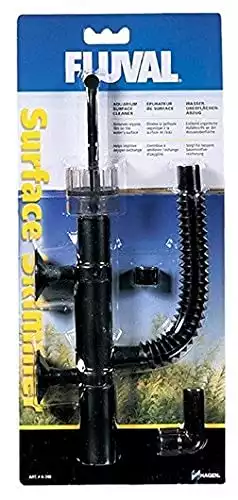
Comments (35)
Thank you! I just saw this film on my aquarium this morning (1 out of 5 so I guess not bad) and freaked! Now I know how to fix it. Thank you!
Hi Lorena,
Glad we could help. While that oily film may look disgusting, in most cases it’s an easy fix. I hope you were able to fix it!
Grabbed a skimmer. Works so good. Sucks all the oily mess from the surface without any effort from me. No more oil.
Hi Jessa,
Glad to hear that the surface skimmer is keeping your tank oil-free, there is no denying that they work well. I just don’t like that they add an extra piece of equipment to your tank. My preference is to try and figure out the cause of the oil slick first and using a skimmer as a last effort.
Hi, thanks so much for posting this. I have a brand new 5 gallon Fluval Spec with a male betta. I am fishin cycling, i had no other choice. And I am supplementing with Seachem Stability to jump start the nitrogen cycle. I have a pretty bad white/gray sludgy biofilm going on. Anytime I touch the water or my fish breaks the surface it breaks up in that section and particles sink to the bottom, some get sucked into the intake. Is this just normal? Part of a new aquarium? I’m not too worried about it….I’m expecting this to go away naturally. Is this nothing to worry about? thank you.
Hi Kodee,
If it’s thick and chunky, you can try scooping as much as you can out off the surface. A fine aquarium net, such as one used to scoop out baby brine fish, will work well. Once done, pointing your filter outlet at the surface should help break down the smaller parts.
If, after that, it goes away and doesn’t return then it’s all good. If the slimy surface comes back then you will need to investigate what is causing the problem. It could be your bottled bacteria, food, etc. Unfortunately, it can take a little trial and error to find the cause.
Kodee, which skimmer did you get? I tried one of the cheap ones. It did do its job, but really didn’t fit my tank very well, and was rather unsightly inside the tank.
Hi Phil,
While I plan to test these in the future, a member of my local fish club uses a Jardli glass skimmer, which is by far the best looking skimmer I have seen in that it blends into the background. His only complaint is that it’s difficult to clean – it doesn’t remain crystal clear. His solution was to then he take it apart and dunk it in his shrimp tank and they get rid of most of the gunk for him.
I initially looked at this page because I have two aquatic turtles that recently I’ve had to be relocated to a tank with less water and the film has started to appear where I never had a film in my larger tanks so I think it is the poop that’s giving it problems because I remove them for their feedings and right now I don’t have a pump that is able to reach the bottom of this very deep tank so the paper towels work once I’ll keep trying them again and again until they don’t work anymore.
Hi Hannah,
Being a fish guy myself, I don’t have any experience with turtle tanks. With that said, are you able to vary their diets?
I have had a painted turtle before me and my wife moved. We used a canister filter with pvc to extend down to the water the outlet at the top of the water and inlet side at the bottom. We would also do water changes every week and filter every two cleaning it out.
I have 4 Beta bowls above my kitchen sink so I’m guessing the oil is from cooking although I honestly don’t cook much that requires oil . I have been doing the paper towel suggestion and it works well in between water changes . There’s not much chance I’ll be moving them as they get the most attention while I’m at the sink . They each have their own personality and make doing dishes a pleasure. Thanks for your help
Hi Sheila,
It is always surprising just how little oil it takes to cause a slick on the surface of a tank. I am happy to hear you have found a solution.
What size tanks? Bettas need a 2.5 or larger with a heater and filter. Kitchens are usually not a great place for fish, or birds.
I noticed that my female bristle nose has white spots on her head and her tail looks all shredded. She sits on top of my power filter all day. Does not eat, but is impossible to catch. She has heaps of offspring in the tank. Today she was not seen. Could this cause an oil slick? I have so thick plants and my tank is very large. Not easy to find fish in here. My Discus seem fine.
Hi Hanna,
I don’t think that a pleco sitting on top of your power filter would cause an oil slick.
White spots usually represent “ick”. Shredded tail, she is probably being picked on and the stress has caused her to get sick. SHe needs treatment ASAP to avoid any further suffering.
We have a one gallon beta tank. We recently have oil on top and algae growing on items in the tank. We don’t allow extra food to stay in the tank, no kiddos hands in the tank or anything else. We also turn the light off from 8pm-8am. Do you have any other suggestions or treatments to stop this?
Hi Bea,
Your problem here is very likely . 1 gallon is too small for even a single betta (although big chain pet stores would have you think otherwise) Water quality issues quickly arise in tanks this small and generally need frequent water changes. Believe it or not, it’s more effort to keep a 1 gallon tank clean than a 2.5 or 5 gallon on account of how quickly the water quality diminishes.
If you don’t want to buy a larger tank, then you’ll have to squeeze a filter in and buy an aquarium test kit – this is the one I recommendm it will last you years, and allow you to quickly determine any issues as they arise. Next, ensure you have a filter, a small sponge filter attached to an airstone will do and make sure the current is low, betta don’t do well in strong currents.
I am working at cycling a 5 gal tank with a good hob filter a 1 young beta. using prime and bacteria supplement every day. I do a 50% water change 24 hrs after I dose with prime and bacteria. Always get a .5 ppm ammonia reading. Took a reading after the water change the amiona reading is always the same no matter what. When I had the little beta in a gal. Fish bowl I had to change the water every day and used prime and water was so toxic. Use r/o water checked it 0 amiona. I know it’s the dust particles when they it water turns to amiona. For every problem there is an answer. Thanks once again.
Hi Ruth,
If you are doing a fish-in cycle then ammonia is to be expected – that’s what cause the ammonia to appear. This ammonia is likely coming from your fish, food and other things in your tank. Once your tank is cycled this will no longer be there.
Drop a deuce, I love it! Thanks for another great article Ian. We have tons of bio film every week on our tanks and manually remove it a couple of times a week. We even posted a short YouTube video of us doing it. I actually considered writing an article on it, but you have it covered. We have considered surface skimmers and saw some really cool ones at Aqua Forest Aquarium made by ADA, but they were not cheap.
We feed our fish oily foods so that has to be the culprit.
Thanks again Ian, keep posting!
Hi Ben! Good to hear from you 🙂
I checked out your youtube video, it’s neat. I am happy to embed it in this article if you would like, it will help get your views up. No pressure if you don’t.
Oh, I find myself drooling over ADA products before their price tag snaps me back to reality. The aquatop skimmer is actually really good, it’s performance surprised me, it even outperformed the Eheim which is similarly designed but at a higher price point. As long as you replace the suction cups, those things suck. Well, actually, they don’t. That’s the problem. But that’s an easy fix, replacement suction cups are easy to come across.
Thanks for dropping in!
Hi Ian,
If you think the video would be beneficial for this article, go for it!
Already added. I gave your blog a shout-out too. Thanks Ben!
i just use a water bottle to remove it.
Hi Sue,
That can also work, although depending on the size of your tank, it may take multiple trips, especially if you don’t have a steady hand and scoop up too much water along with it. Sometimes the simplest solutions really are the best, right? Thanks for sharing.
I’m really grateful for the info you posted!! I’m doing a fish-in cycle with a new 10 gal for a beautiful HM King betta ( I realize that’s a “Petco” name).
I wasn’t too worried about the cycle because I used the TSS bacteria along with gravel & a filter from an established aquarium. However I was pretty freaked out when I noticed a huge oil slick today, until I came across your post. Paper towels worked wonders!
Thank you so much!
hi Cathy,
I’m glad I could help! It’s possible either the gravel or filter had trapped proteins and oils in them, it can happen depending on how well the other tank has been maintained. Wishing you all the best of luck with your cycling process!
Very helpful! I made a newbie mistake of placing my aquarium in the kitchen because of the natural light it gets. Now to find a new spot…
I have been getting oil slicks all summer and haven’t been able to figure out why. Frustrating!!! Reading your web site, it occurred to me that I was using fans a lot due to the summer heat. But why would that cause a problem? I have automatic areasol sprayers all over. Not close to tanks but the fans carry the air everywhere. Who knew? Thank you so much!
Hi Carene,
It doesn’t take much oil to cause an unsightly slick. If the problem goes away in the winter months, then I think you are on the money with the air circulation!
Very informative and entertaining article to read. The solutions in this publication helped me clear the film and keep it gone. Thank you!
So here we are 2024, and oil slicks daily! Very frustrating for sure. Not only oil slicks, but I am at cleaning the 3.5 tank ( 1 small female betta) weekly. Algae starts building…. Maybe I just suck at being a fish parent😞
Hi Rhonda. Don’t be too hard on yourself—maintaining an aquarium can be challenging, but you’re doing a great job seeking solutions! Oil slicks are often caused by excess organic materials such as food and natural oils from the fish itself. To manage this, consider feeding your betta slightly less, or ensure that the food is completely consumed within a few minutes. For the algae issue, reduce light exposure and make sure you don’t overfeed. A small tank filter designed for a 3.5-gallon tank might also assist in keeping the water cleaner and reducing both oil slicks and algae. Keep at it, and you’ll see improvements!